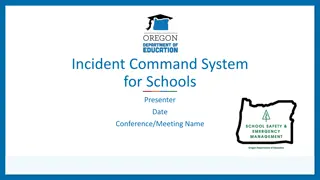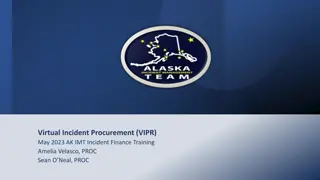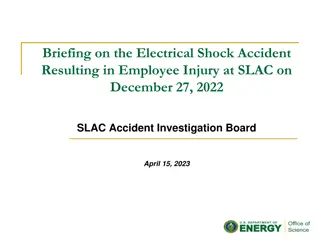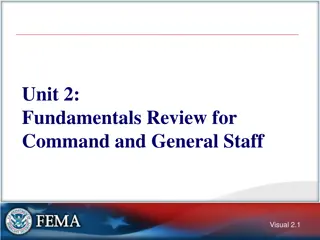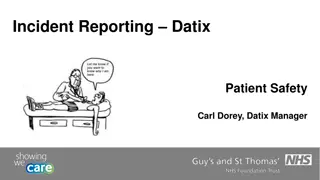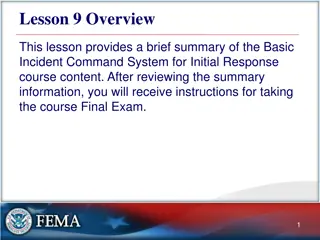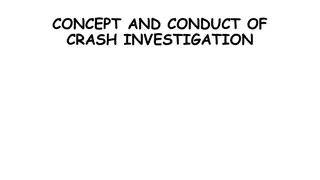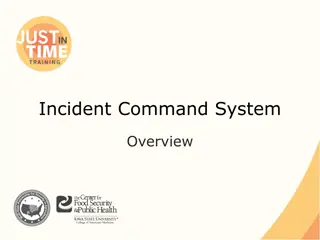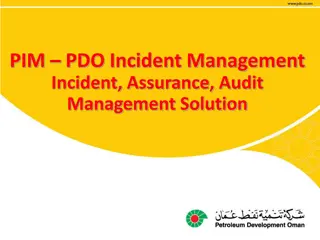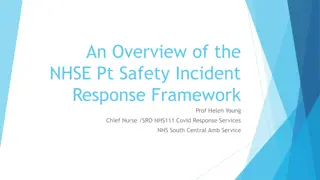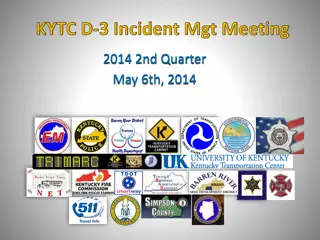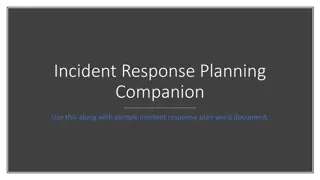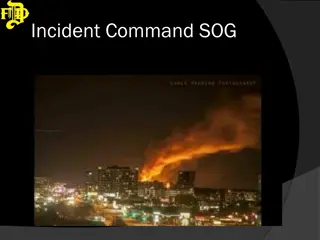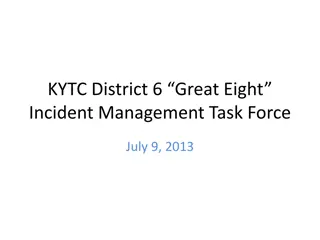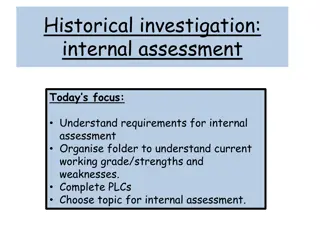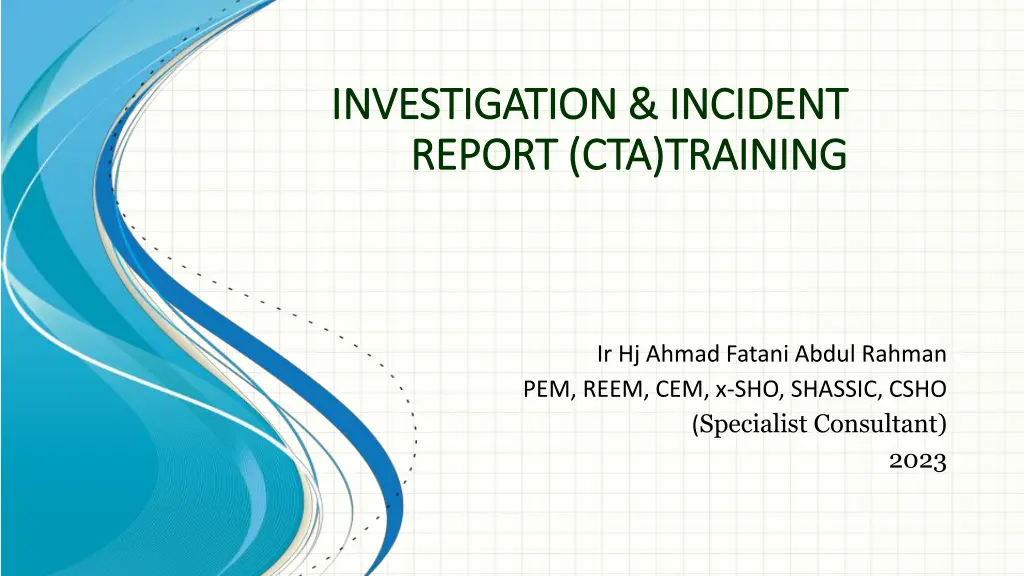
Effective Incident Investigation and Corrective Action Techniques
Enhance your incident investigation skills with in-depth training reports and familiarization protocols. Learn how to conduct cause tree analysis to categorize accident causes and implement corrective actions effectively.
Download Presentation

Please find below an Image/Link to download the presentation.
The content on the website is provided AS IS for your information and personal use only. It may not be sold, licensed, or shared on other websites without obtaining consent from the author. If you encounter any issues during the download, it is possible that the publisher has removed the file from their server.
You are allowed to download the files provided on this website for personal or commercial use, subject to the condition that they are used lawfully. All files are the property of their respective owners.
The content on the website is provided AS IS for your information and personal use only. It may not be sold, licensed, or shared on other websites without obtaining consent from the author.
E N D
Presentation Transcript
INVESTIGATION & INCIDENT INVESTIGATION & INCIDENT REPORT (CTA)TRAINING REPORT (CTA)TRAINING Ir Hj Ahmad Fatani Abdul Rahman PEM, REEM, CEM, x-SHO, SHASSIC, CSHO (Specialist Consultant) 2023
REFRESH / FAMILIARIZATION OF PTTEP & REFRESH / FAMILIARIZATION OF PTTEP & MALAYSIA AUTHORITY INCIDENT MALAYSIA AUTHORITY INCIDENT MANAGEMENT PROTOCOLS MANAGEMENT PROTOCOLS (STANDARD, GUILDELINES & PROCEDURES) (STANDARD, GUILDELINES & PROCEDURES)
INVESTIGATION AND CORRECTIVE ACTION HOW DO WE INVESTIGATE? CAUSE TREE ANALYSIS PLEASE REFER TO CTA CTA Handbook_Revised_6 June 08
INVESTIGATION AND CORRECTIVE ACTION HOW DO WE INVESTIGATE? CAUSE TREE ANALYSIS Causes of accident can be categories into; 1. Direct cause / immediate 2. Undelaying cause 3. Root cause
INVESTIGATION AND CORRECTIVE ACTION HOW DO WE INVESTIGATE? CAUSE TREE ANALYSIS Causes of accident can be categories into; 1. Direct cause / immediate The cause that directly resulted in the event Ex. Hit by hammer. Hammer slip from hand Disintegration Victim stand in front
INVESTIGATION AND CORRECTIVE ACTION HOW DO WE INVESTIGATE? CAUSE TREE ANALYSIS Causes of accident can be categories into; 2. Underlying cause The cause(s) between direct causes and root causes by itself may not cause the event Ex. Slip from hand. No proper grip wet hand Inadequate strength - fatigue Shock disturbed by co-worker
INVESTIGATION AND CORRECTIVE ACTION HOW DO WE INVESTIGATE? CAUSE TREE ANALYSIS Causes of accident can be categories into; 2. Underlying cause Most of it unsafe acts and unsafe conditions and can be categorised as follows: 1. Human behaviour 2. Design of equipment and plant 3. Systems & procedures including use of materials 4. Environmental surroundings
INVESTIGATION AND CORRECTIVE ACTION HOW DO WE INVESTIGATE? CAUSE TREE ANALYSIS Causes of accident can be categories into; 3. Root cause The fundamental reason for an event which if corrected would prevent reoccurrence Ex. Fatigue. No proper rest no proper rest arrangement for worker (assuming there is nothing stopping from establishing the rest arrangement)
INVESTIGATION AND CORRECTIVE ACTION HOW DO WE INVESTIGATE? CAUSE TREE ANALYSIS Causes of accident can be categories into; 3. Root cause PEOPLE (Personal) Factors Lack of knowledge or skill, improper motivation, physical or mental conditions PLACE (Job) Factors Physical environment, sub- standard equipment, abnormal usage, wear & tear, inadequate standards, design & maintenance, purchasing standards PROCESS (Supervisory) Performance Inadequate instructions, failure of SOPs, rules not, enforced, hazards not corrected, devices not provided PROGRAM (Management Policy & Decisions) Measurable standards, work in progress measure , work-v- standards, evaluation , corrective action
INVESTIGATION AND CORRECTIVE ACTION HOW DO WE INVESTIGATE? CAUSE TREE ANALYSIS The detail of the Analysis is based on 5 WHYs
Causal Tree Analysis Sample
Cause Cause Tree Tree Analysis Analysis
Causal Tree Analysis Steps in Developing a Cause Tree: After the first level causes are determined move down the tree one branch at a time to the end of the branch. Usually one or more Physical Causes come first, followed by one or more Human/Behavioral Causes, followed by a single System level Root Cause. As each box is added, ask: "Is this the direct cause of the event or cause in the box immediately above? There are three ways a branch can end: A Root Cause (system level cause) is discovered A Proper Condition is discovered The potential cause is found not to be a factor in this incident and is lined out, but is left on the tree to add clarity.
Causal Tree Analysis Steps in Developing a Cause Tree: Identify the primary event at the top of the tree. Identify the two or three physical or human/behavioral causes that directly caused the primary event. Next, work one branch at a time to its end. Brainstorm all of the physical causes that reasonably could have caused the initial actions or conditions. Include any protective systems, such as trips, alarms, and so forth that may have failed. Physical causes are the easiest to identify and correct, and therefore investigations too often stop here. When this happens, the root cause goes undetected and is not corrected. The physical cause reappears and the event/incident repeats. Systematically rule out brainstormed physical causes by applying the facts learned and the verification steps discussed in the next section. If you determine that a potential cause wasn t valid in this particular case, X it off and document why in the Verification Log. Keeping it on the Cause Tree and Verification Log will enable the team and reviewers to know it was looked at. If you determine that it was a valid cause, but is a proper condition, end the branch with the words ProperCondition below the cause.
Causal Tree Analysis Steps in Developing a Cause Tree: A propercondition is a condition within which the equipment or process was designed to operate and is accepted by the team as not needing to be fixed. For example, a fire that occurs in a building could only have occurred if there was oxygen present. But since people are located in buildings, oxygen must be there. So although oxygen is a cause of the fire, it is a proper condition. Calling a cause a propercondition should be a team decision. There are often several successive physical causes. Add as many as needed to capture the details. For example, the oil leaked because the pipe broke, and the pipe broke because it was vibrating. It was vibrating because it was attached to a malfunctioning pump that was vibrating. Identify the possible human/behavioral causes for each physical cause. A human/behavioral cause can be something that a person did or didn t do. For example, a bearing could be dry because no one lubricated it. These causes are identified based primarily on interviews. Look for failed protections too. They could be procedures or instructions which were in place to prevent the incident, but were not followed for some reason. Remember this isn t a fault-finding exercise. The fact that a procedure wasn t followed doesn t imply blame. It s just an event which needs to be entered on the Cause Tree. Do not rule out possible human/behavioral causes in the same way you ruled out possible physical ones. It is easier to re-interview the person than speculate on human thought processes.
Causal Tree Analysis Working through Human/Behavioral Causes Often incident investigation teams struggle with human/behavioral causes, especially with procedure not followed and knowing when discipline is appropriate. A template is included in Appendix C to provide guidance for taking cause trees past the human/behavioral causes down to the system level causes. Identify possible management system causes for each human/behavioral or physical cause. Typical management system causes might include: procedures which don t exist or are wrong or misleading, not covered in training, no preventive maintenance, no auditing, etc. Stop asking Why when you: Find a system level root cause that you have control to fix. Reach a proper condition (a proper condition is a real cause, but it is one that is acceptable and does not need fixing), or The cause is verified as not true or found not to be a factor in the incident. Recommend to put root causes in ovals on the Cause Tree to easily distinguish them.
Causal Tree Analysis SAMPLES:
Causal Tree Analysis Verifying Potential Causes Visual Testing/Lab Analysis Expert Theory Conventional Written Data Interviews
Causal Tree Analysis Categorization of the Root Causes and the Incident 1. Risk Assessment 2. Procedures & Safe Work Practices 3. Design 4. Pre-Startup Safety Reviews 5. Inspection / Quality Control 6. Preventive Maintenance / Repeat Failure 7. Human Factors 8. Management of Change 9. Training & Competency 10. Contractor Safety 11. Communications 12. Supervision 13. Incident & Near Miss Investigation 14. Emergency Response 15. Audits 16. Leadership and Accountability 17. Behavioral Based Safety & Safety Observation 18. STOP Work Authority 19. Natural Phenomenon
Causal Tree Analysis Example or Sample of Categories of RCA:
INVESTIGATION AND CORRECTIVE ACTION HOW DO WE INVESTIGATE? REPORT WRITING Clear, complete description and accurate information of events leading up to the accident Clear, complete and correct identification of all causal factors Recommendations Supporting documentation Proper review and sign off
INVESTIGATION AND CORRECTIVE ACTION HOW DO WE INVESTIGATE? REPORT WRITING Develop SMART recommendations: Specific Measurable Accountable Time limits
INVESTIGATION AND CORRECTIVE ACTION ACTION (CORRECTICE AND PREVENTIVE) Preventive and corrective action should be carried out for: Incidents Management system non-conformances Recommendation(s) for preventive and corrective actions must be communicated clearly
INVESTIGATION AND CORRECTIVE ACTION ACTION (CORRECTICE AND PREVENTIVE) Must be based on root causes Appropriate to the problem at hand Reviewed through risk assessment process to ensure that the correction will not introduce a new hazard Strict time table for implementation established Follow up conducted
Causal Tree Analysis Cause Tree Analysis Checklist
INVESTIGATION AND CORRECTIVE ACTION Summary Aim of investigation is to find root causes. Purpose is so that similar incident will not be repeated. Prepare organisation, procedure and equipment in Anticipation of Incidents. Corrective and Preventive Action should be carried out for incidents and management system non- conformances.
ABILITY ABILITY TO LESSONS LESSONS LEARNED TO DO LEARNED FROM DO CAUSE CAUSE TREE FROM INCIDENTS TREE ANALYSIS ANALYSIS AND INCIDENTS AND DEVELOP DEVELOP
BENEFIT BENEFIT FROM FROM THESE THESE ACTIVITIES ACTIVITIES IMPROVE THE QUALITY OF THE INVESTIGATION REPORT LESSON LEARNT AND MINIMIZE IT FROM HAPPENING AGAIN ABILITY TO FIND THE ROOT CUASE FOR INCIDENT WITH CONSTRUCTIVE MANNER FOLLOWING THE COMPANY STANDARD & REQUIREMENT BY USING CAUSE TREE ANALYSIS (CTA) PROCESS ABLE TO IMPROVE THE WORKING CONDITION AND AVOID FUTURE ACCIDENT & INCIDENT TO UNDERSTAND THAT IT IS NOT ONLY THE REQUIREMENT FOR THE COMPANY BUT FOR JV PARTNER PETRONAS LOCAL & NATIONAL AUTHORITY AND BODY


